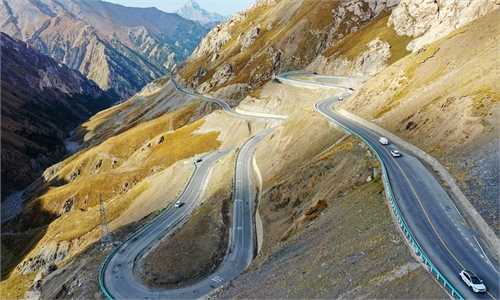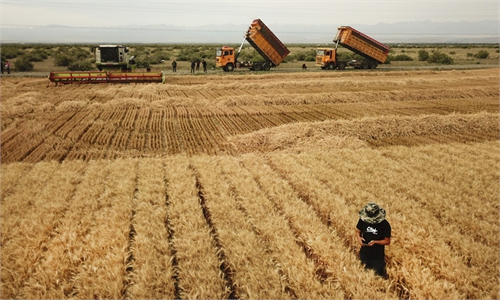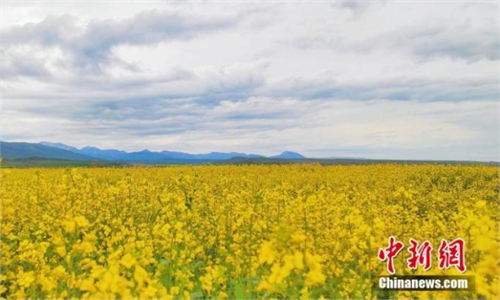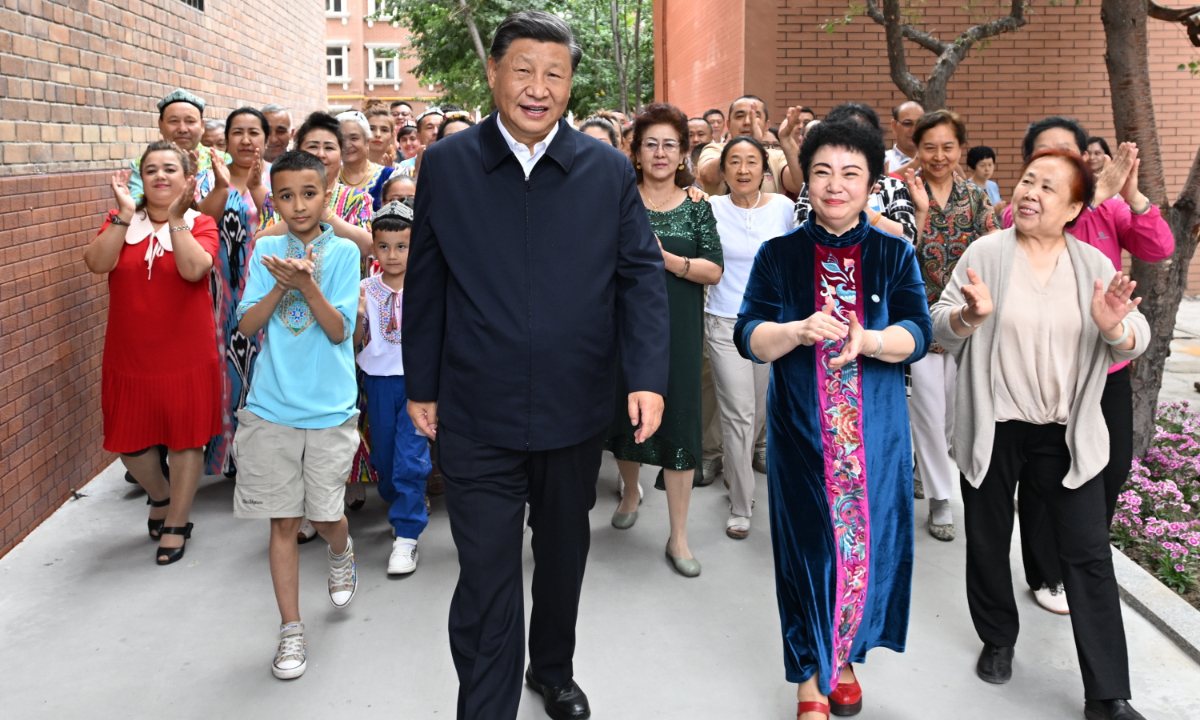
Chinese President Xi Jinping talks with residents in the Guyuanxiang community in Tianshan district, Urumqi, during his visit to Northwest China's Xinjiang Uygur Autonomous Region from July 12 to 15. Photo: Xinhua
Eight years after his visit to China's Xinjiang region in 2014, Chinese President Xi Jinping made a second trip to the northwest region and stressed efforts to fully and faithfully implement the policies of the Communist Party of China (CPC) for the governance of Xinjiang in the new era, highlighting social stability and lasting security as the overarching goal and the region's significant role in building the Belt and Road Initiative.
Analysts said Xi's visit to Xinjiang signals that after achieving fundamental changes from disturbance to stability, the Xinjiang region is entering a new phase of being built into the bridgehead of China's westward opening-up, despite the US' economic suffocation of the region.
While staying in the Xinjiang region from Tuesday to Friday, President Xi visited many places in Urumqi, including Xinjiang University, the Urumqi International Land Port Area, the Guyuanxiang community in Tianshan District and the Museum of the Xinjiang Uygur Autonomous Region. He also went to Shihezi and Turpan and inspected villages and the Xinjiang Production and Construction Corps (XPCC) and had communications with local residents.
On Friday afternoon, residents of all ethnic groups saw off Xi with prolonged applause before him returning to Beijing.
During the visit, President Xi also called for developing Xinjiang into a region that is united, harmonious, prosperous, and culturally advanced, with healthy ecosystems and people living and working in contentment.
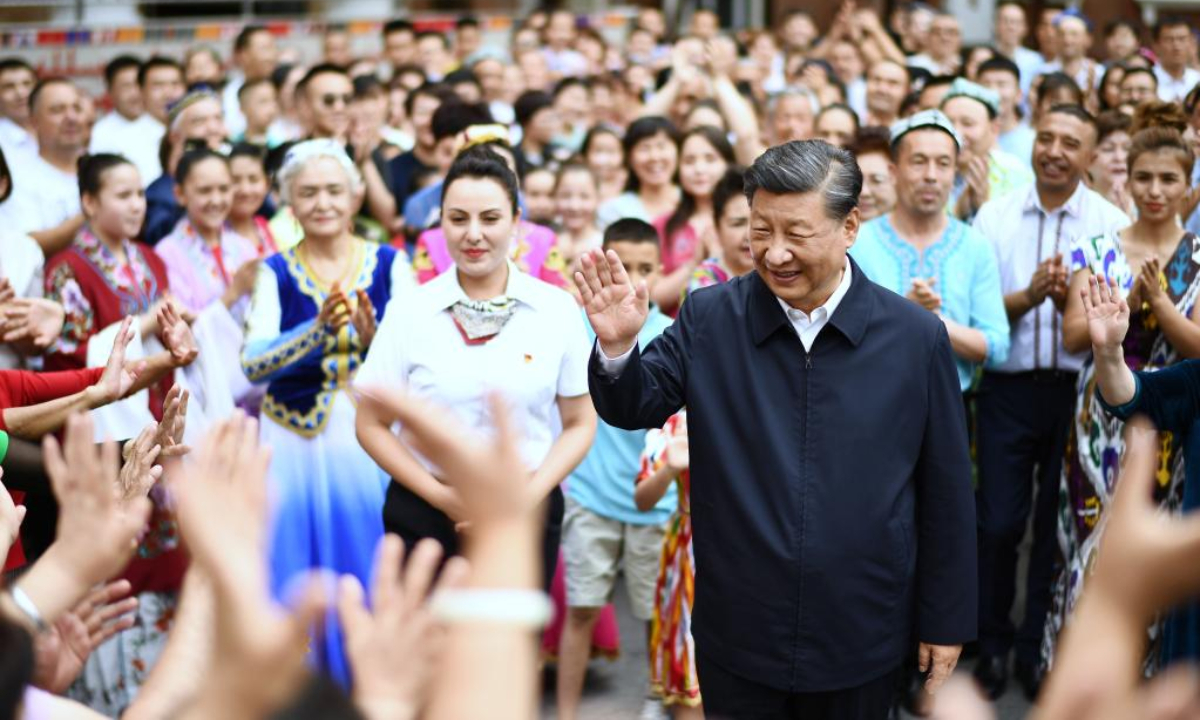
Chinese President Xi Jinping, also general secretary of the Communist Party of China Central Committee and chairman of the Central Military Commission, waves to people of various ethnic groups while visiting the community of Guyuanxiang in the Tianshan District in the city of Urumqi, capital of northwest China's Xinjiang Uygur Autonomous Region, July 13, 2022. Photo:Xinhua
Xi's visit to the Xinjiang region is a strong and significant indication that while maintaining prolonged stability and achieving economic development, Xinjiang region is stepping into a new phase of economic development and has been built as a core hub for the building of China's Belt and Road Initiative and the bridgehead for westward opening-up, Wang Yuting, associate professor of the Institute of Chinese Borderland Studies at the Chinese Academy of Social Sciences, told the Global Times.
Soon after Xi's visit to Xinjiang in 2014, the second symposium on the region's work was held in May in Beijing and stressed long-term stability as the main goal for the region. Under this guidance, over the past eight years, the region has experienced fundamental changes, going from disturbance to social stability.
After getting rid of the influence of terrorist attacks, Xinjiang and the whole western region of China have realized stability, laying the foundation for China to further boost its western region and deepen cooperation with Central and West Asian countries, said Wang Yuting, noting that Xinjiang's role as a core hub of the Silk Road Economic Belt has significant strategic value and meaning, especially amid the global changes brought by the Ukraine crisis.
While Xinjiang has achieved social stability, safeguarding this hard-won situation is not easy, especially with the US and some Western countries smearing China on human rights, Wang Jiang, an expert at the Institute of China's Borderland Studies at Zhejiang Normal University, told the Global Times.
Achieving long-term stability requires long-term prosperity, and to achieve long prosperity, the region should be integrated into the nation's development. Building it as a hub for westward opening-up aims to help it find new places in global trade and to break the US economic blockade on the region, Wang Jiang said.
In addition to economic development, ethnic unity and cultural heritage were also key words for President Xi's visits in Xinjiang. While staying in Urumqi, President Xi visited the Guyuanxiang community in Tianshan district. Xi said he pays great attention to community work and is very glad to see local communities thriving. Xi also watched a Manas performance and said that Chinese civilization is extensive and profound, and has a long history stretching back to antiquity.
Wang Yuting also pointed out that President Xi's visit in Xinjiang also showcased China's enriched policy for the governance of Xinjiang in the new era, including maintaining stability in the region through ethnic unity, nurturing the cultures of Xinjiang, promoting prosperity among the local residents, and developing Xinjiang from a long-term perspective.
Cultures of ethnic groups in Xinjiang are also important parts of Chinese culture and this is why President Xi went to the museums and stressed heritage protection, the expert noted.
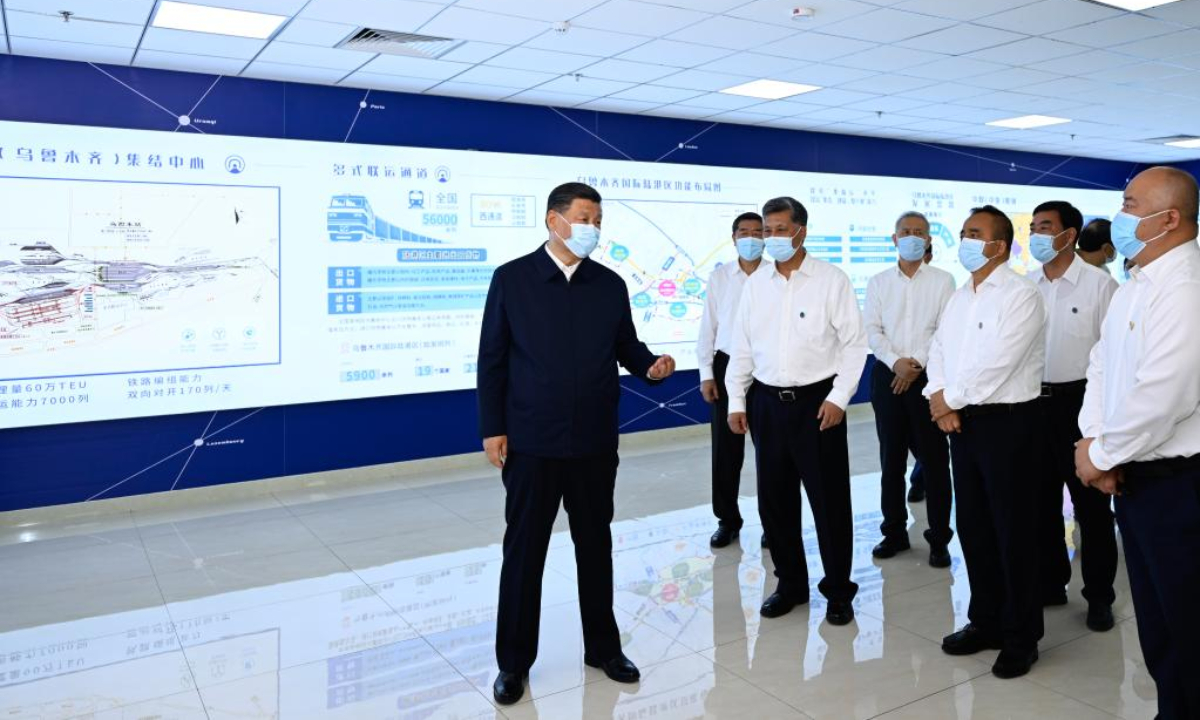
Chinese President Xi Jinping, also general secretary of the Communist Party of China Central Committee and chairman of the Central Military Commission, visits the Urumqi International Land Port Area in the city of Urumqi, capital of northwest China's Xinjiang Uygur Autonomous Region, July 12, 2022. Photo:Xinhua
Eurasia hub
The Xinjiang region, once an important passage of the ancient Silk Road, has become a key gateway of China's westward opening up and the core area of the Silk Road Economic Belt, analysts said, hailing the region's prominent advantages in deepening foreign exchange and cooperation, including its unparalleled geographic location, abundant natural resources, profound cultural heritage and preferential policies.
On Tuesday, Xi visited the Urumqi International Land Port (UILP) and observed the operation of various functional areas of the China-Europe Freight Train (Urumqi) assembly center and the Alashankou and Khorgos ports on real-time video.
"The Belt and Road Initiative has yielded fruitful results since it was initiated. As the joint building of BRI continues to advance, Xinjiang is no longer a remote corner but a core area and a hub. What you have done is of historic significance," Xi said.
President Xi's inspection of the UILP shows that China's attitude and determination to open up to Central Asia and boost the development and opening of western China have not changed, Liu Zongyi, secretary-general of the Research Center for China-South Asia Cooperation at the Shanghai Institutes for International Studies, told the Global Times on Friday.
Liu noted that in the past, China opened up to the sea and now we are also paying attention to opening up on the land, in other words, China's opening-up not only engages with developed countries but also developing countries.
During his visit in April 2014, President Xi pointed out that the Xinjiang region has an irreplaceable position and role in building the Silk Road Economic Belt. One month later, the Political Bureau of the CPC Central Committee proposed making efforts to build Xinjiang into a "core area" of the Silk Road Economic Belt.
UILP, which was launched at the end of 2015, is a landmark project in carrying out the construction of the core area of the Silk Road Economic Belt and is committed to developing itself into an international land logistics hub that connects Eurasia, an international supply chain organization center, a highland for attracting modern industries and an important functional area of China's free trade pilot zone, Zhong Hehua, deputy director of Development Service Center of the UILP, told a press conference on Tuesday.
UILP is also an important hub for China-Europe freight trains. Previously, these freight trains were scattered across China, resulting in low efficiency and small volumes of freight traffic in each city. The UILP has effectively adjusted and integrated freights and reduced transportation times, Zhao Juan, a research fellow with the China Railway Economic and Planning Research Institute, told the Global Times on Friday.
President Xi's visit to UILP sent an important signal on the trend of integrated China-Europe freight trains and also highlighted their important role in promoting logistics along the Belt and Road route, Zhao said, pointing out that China-Europe freight train trips have increased since the pandemic and have been responsible for the majority of freight transport in the post-pandemic era.
According to data from the Xinjiang regional government, to date, Xinjiang has run more than 5,900 China-Europe freight trains, and UILP has run a total of 609 China-Europe trains from January to June 2022, a year-on-year increase of 36 percent.
China's products can be exported to the US and the West from coastal areas and also to other regions via the land hub of Xinjiang, which can not only meet the increasingly strong demand from neighboring countries but also help speed up the region's opening-up to find new ways out amid the US economic suffocation, Wang Tingyu said.
In recent years, the US and some Western countries, together with anti-China forces, have smeared China's policies in Xinjiang and made groundless accusations of "genocide" or "forced labor." On June 21, the US' so-called Uyghur Forced Labor Prevention Act (UFLPA) took effect and bans products made in China's Xinjiang, smearing the Chinese government over "oppression" of the Uygurs and other minority populations in its Xinjiang region.
Analysts criticized the US law as an escalation to contain China by using human rights topics in the Xinjiang region as excuses, and pointed out that such malicious acts severely violate international trade rules and affect the stability of the global supply chain.
However, in facing with the US economic blockade, the total volume of foreign trade in the Xinjiang region has increased with wider cooperation with more countries. According to data from the Xinjiang regional government, from 2016 to 2021, the total volume of foreign trade in Xinjiang increased from 139.8 billion yuan to 156.9 billion yuan. Xinjiang gained an increasing number of trading partners in more than 170 countries and regions.
Wang Jiang noted that despite the West's and US' smear campaign against the Xinjiang region, its development and stability have been witnessed by more people who have visited the region.
"China has always been open and invited others to visit the region, including the UN human rights chief. While debunking the lies created by some anti-China forces, we also focus on the region's development to benefit the residents of ethnic groups," Wang Jiang said.
